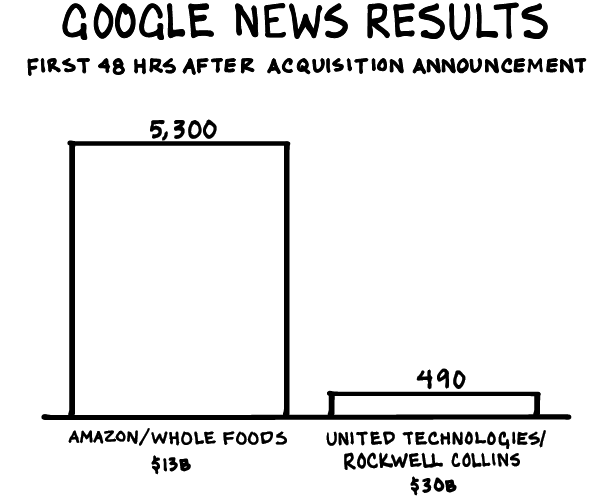
Bread Crumbs
Bread Crumbs
We are in 2–3 meetings a week with CMOs and CEOs of large consumer firms. My role is to pretend I’m on their board and discuss what they should be focusing on, and why. We then do an exercise where we imagine the market cap of the firm increasing 3x within five years, and work backwards. What are the most likely scenarios that would result in a tripling of value in half a decade, and how might that impact capital allocation (term I use for “decision” to sound smart)?

Most VCs and CEOs will claim they’re focused on building a great company, and that the exit will take care of itself. But many also envision an irrational exit and work backwards. It’s a useful exercise. I’ve found when financiers or entrepreneurs say they’re not in it for the money, that’s code for “I’m obsessed with the green stuff.” More and more VCs are open about their time horizon and return expectations.
So, to illustrate the process, below are thoughts on scenarios that could result in a tripling of value for several classes of firms:
— Old-world retail (M, KSS, WSM, RH, JWN, ASNA, etc.): Data / earnings show that, though things are bad, you’re not going out of business. Plan 12–24 months of aggressive cost-cutting that sheds fat (vs. muscle). Begin lapping weak yoy sales, start playing offense with initiatives that provide shark repellent — ability to compete … and win against Amazon. Think of, and remake, your stores as assets (vs. liabilities). Best Buy is one of the best examples — doubling down on their Blue Shirts and in-store service when the going got rough. Starbucks is the ultimate arbiter here, spending more on employee benefits than it does on coffee beans. Invest in geographic, shopping-format-specific omnichannel offerings. While same-day delivery is a loss leader, can you scale it at least in New York, if not nationwide? If your primary store footprint is in malls, what’s a viable, convenient alternative to click and collect, which just doesn’t work in that format? In addition, pee on more fire hydrants and get louder (in the media) with your initiatives, even if they may or may not work … or even happen. Amazon has turned the media into their bitch — NYT, WSJ, and Financial Times have become the mouthpieces of Amazon’s investor relations department.

— Old-economy firms in sectors that are in structural decline or distress (yellow pages, Kodak, catalog, radio, department stores): Be an adult and acknowledge you are in structural decline and ring-fence the spend on “growth” initiatives. Demonstrate an ability to slow the decline to a number that’s the same as, or less than, the costs you take out of the business. Avoid expensive procedures to keep grandma alive. Your market value has likely been so hammered that milking the firm can produce extraordinary shareholder value as long as you don’t pretend you’re young and make stupid acquisitions or expensive hires (as Yahoo did). Having worked across the lifecycle of firms (startup, growth, mature, distressed), I believe, on a risk-adjusted basis, the best place to invest is distressed. Our desire to procreate translates to an obsession with youth — a bias that overvalues young hot firms and undervalues that aged. Macy’s may (or may not) be dying, but it’s not dying in five years (trading at around 5x EBITDA).
— Rolex, Nike, Samsung: Put in place a plan to increase percentage of sales via vertical channels to 30–50% within the decade. Massively difficult and expensive, but you have no choice. Broadcast is dying, and to maintain the brand equity that supports irrational margins will require these firms to build equity at point of sale, vs. just harvesting it there. The majority of aspirational brands have seen their third-party distribution bifurcate into two categories: partners who appreciate their brand equity and are in structural decline, like department stores, or growth channels that are using their brand as bait to swap in private-label brands or slowly starch the margin, like Amazon and Sephora. Apple’s genius move wasn’t the iPhone, but investing where brand equity was moving, at purchase, and opening extraordinary temples of brand worship.
— $1–3B consumer brands holding their own — flat to high-single-digit growth: Sell. Market dynamics trump individual performance, and the markets are at all-time highs. While you won’t get a 3x premium to sell, you’ll get a 20–40% premium, which is likely 3x what your firm will be worth in three years. Why? $1–3B firms are in no man’s land. Not small enough to present the agility and growth rates of long-tail brands, but not big enough to allocate the requisite capital in the arms race that is digital.
— Uber, WeWork, and other (massively) overvalued unicorns: Raise as much money as possible and buy old-economy assets (cars, buildings, etc.) to build analog moats around your businesses / valuations.
— Amazon: For a variety of reasons, Amazon is tracking to this. In this instance, it’s more interesting to posit why they might not get to a trillion and address the risks. The only thing, in my view, standing in the way of Amazon and a trillion market cap is themselves. Or specifically the perception that they have become, or will soon become, too powerful or are not a good citizen. How to address? Amazon should spin AWS as a prophylactic — break themselves up. It would mute, for a while, concentration of power concerns and will have the added benefit of being good for shareholder value. They will also need to find a way to hire more humans and pay more taxes. Yes, paying taxes will add shareholder value at AMZN.
The most disturbing stat in business? Since 2008 Walmart has paid $64B in corporate income tax, while Amazon has paid $1.4B.1 This is despite the fact that, in the last 24 months, Amazon has added the value of Walmart to its market cap. The most uncomfortable question in business, in my view, is how do we pay our soldiers, firefighters, and teachers if a firm can ascend to $460B in value (#5 in the world) without paying any meaningful corporate taxes.
First / Last Home
In a capitalist society, we mark life by our purchases. The first big purchase is an engagement ring that De Beers convinced young men to massively overspend on, as it was a “store of value,” and generally fit a strange notion that we were marking our property with an item that reflected our level of manhood … how economically successful we are. The second big purchase: the home. The National Association of Realtors has deftly engendered the notion that the American Dream is home ownership. Ask somebody who purchased a home in 2007 if their “dreams” came true.
Yale economist and Nobel Prize winner Robert Shiller argues that, when maintenance is accounted for, a house isn’t a much better investment than any other asset class. Still, we see our first home purchase as a sign of our progress and trajectory as adults. The government has bought into this (see above: National Association of Realtors), and the interest on your mortgage is tax deductible. The mortgage tax deduction is one of the most costly tax breaks in America. Another? Lower taxation on capital gains, vs. ordinary income. These are both positioned as “American”: home ownership and investing. They are simply transfers of wealth from the poor to the rich. Who owns homes and stocks / assets? Rich old people. Who rents and doesn’t have assets that qualify for capital gains treatment? The young and the poor.
A better proxy for your life isn’t your first home, but your last. Where you draw your last breath is more meaningful, as it’s a reflection of your success and, more importantly, the number of people who have your back. Toward the end, you aren’t adding much value, and people who look out for you are either exceptionally generous or reciprocating your love and support.
My mom’s last home was in a seniors community in Las Vegas. When she moved, I told her to throw out her old furniture, and we decorated the whole place in Pottery Barn — I advised WSM on their internet strategy in the nineties, and a mentor (Pat Connolly, CMO) gave me a discount. It wasn’t having club chairs and chenille pillows that gave my mom joy, but that her son had bought them for her.
When my mom got very sick, and had several surgeries, Kaiser moved her to long-term care. When I walked into the facility, it reeked of urine, and there were people asleep in wheelchairs in the hall. I walked into my mom’s room that she shared with another woman. Her roommate was bedridden and had a TV attached to a metal arm six inches from her face. The TV was blinking on and off. She looked at me and asked if it was too loud. My mom was sitting upright on the edge of her bed waiting for me. She looked at me and said, “I don’t want to be here.” All the fucking fake relevance, semi-internet fame, money, and living large … and my 90-pound mom was trapped in a place that reeked of urine.
I. Had. Failed.
I told my mom to pack her stuff and told the nurses I wanted to take her home. They said that would be “against doctor’s orders,” and that they would call security if necessary. I went outside and told the driver who’d brought me there I would be bringing my mom out in a wheelchair, and that we needed to get her in the car and leave promptly. I was in over my head and didn’t know how to deal with the situation. I went back into the facility, got a wheelchair, put my mom in it, placed her bag on her lap, and headed out. As we passed the nurses’ desk they looked calmly at us, and a large security guard positioned himself between my mom and me, and the sliding exit doors. He didn’t say anything, just stood there.
This is where it would make for a better story if I had I told him to get out of my way, or in a Morgan Freeman voice announced, “I’m taking my mother home.” But that’s not what happened. I froze and stood there, with my hands on the handles of my mom’s wheelchair, her in a hospital gown holding a duffel bag with her stuff. We all stood / sat there for what was likely 10 seconds, but felt like 10 minutes. I think he felt sorry for us, and turned his gaze to the floor, walked away, and we left. My mom passed seven weeks later, at home.
My dad and his wife are moving into what will likely be their last home, both 87. My sister, my dad’s wife’s son and grandson, and I are pulling together to make the move easier and ensure it’s a nice place. My dad told me this will be the first time he can truly relax, as he won’t need to garden or take care of the house. It’s a great place in a university town, movie nights, on-call medical professionals, a pool he can swim in, and we’re arranging for a trainer so he can maintain his lifelong fitness routine.

Your first house signals the meaningful — your future and possibility. Your last signals the profound — the people who love you.
Life is so rich,

1 Source: L2 analysis of Amazon 10Ks and Walmart Annual Reports
0 Comments
Need more Scott in your life?
The Prof G Markets Pod now has a newsletter edition. Sign up here to receive it every Monday. What a thrill.

